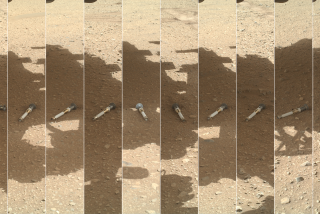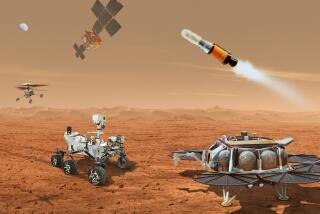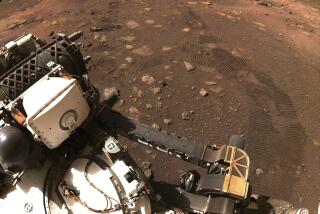NASA plans a kiss-and-tell with an asteroid
- Share via
We’ve brought back dust from a comet; now NASA plans to do the same for an asteroid.
The Osiris-Rex mission will launch in 2016 and head to the near-Earth asteroid known as 1999 RQ36, where it will circle for about a year before swooping down and using a robotic arm to scoop up cupfuls of material, which it will bring back for scientists to study.
Asteroids are leftovers from the formation of the solar system 4.5 billion years ago. Having a bit of them to study would be like getting a glimpse into what the early solar system looked like as the disc of debris around the sun began to coalesce into planets, asteroids and other bodies.
The mission, which NASA officials say may cost about $800 million (not including the launch vehicle), is to bring back its sample in 2023.
We spoke with the University of Arizona’s Michael Drake, the mission’s principal investigator, to tell us more about the mission.
Why chase down an asteroid to bring a bit of it home?
We wanted to ask the big questions. Where do we come from? How did we come to exist? What’s the origin of the organic material that provided the building blocks that led to life?
The problem is that planets as big the Earth sterilize themselves during their formation, because they’re melted repeatedly. No organic materials could survive that melting. You, or I, or a tree or a blade of grass is not going to do well sitting up on top of a thousand-kilometer-deep ocean of liquid lava.
So we don’t have any unequivocal, unaltered samples in our laboratories. We already know that amino acids exist in space, and we find them in some meteorites: chipped-off asteroids that strike Earth. We believe it’s the sort of stuff that came in through the Earth’s atmosphere and provided those building blocks after liquid oceans first formed. But anything that enters the Earth’s atmosphere gets contaminated by the Earth’s life forms immediately.
So by visiting this asteroid, we’re bringing back something that is essentially untouched by human hand and has not seen the Earth’s biology and will be a pristine sample of what’s out there. It’s a time capsule containing, probably, the building blocks of life.
What will each instrument do?
There are four principal instruments. The first is a camera system with three different cameras. One is a telescope that doubles as a microscope. The second one basically maps, from orbit, the surface of the asteroid. And the third will provide high-resolution imaging as we go in. Together they will be able to take pictures from when the asteroid is just a far-off point of light, map the surface and look down on it at the sub-millimeter scale.
The next is a visual near-infrared mapping spectrometer. It’s kind of like the cameras, but it’s basically designed to tell us about the mineralogy, and that includes organic material. It would be one of two instruments that help us understand where there’s variation at the surface. If the surface is patchy, we will go to an area where there’s a patch that’s rich in organics.
Then we have the thermal emission spectrometer; it does some of those same things but also tells you a lot about the thermal environment and things you need to know in order to really predict how the asteroid’s orbit changes in response to these photons being emitted differentially from afternoon to nighttime.
And finally, a scanning laser altimeter uses lasers to figure out how close we are to the surface. It gives you a 3-D image of the surface, which is really important for lots of reasons. We’ll need it to select a safe landing site.
There’s also a student experiment. We ran a national competition and the winner was an X-ray telescope from MIT and the Harvard-Smithsonian Center for Astrophysics, which will give us the chemical composition of the asteroid. We don’t need it to fly the mission, but we really like it.
What will the most challenging part of the mission be?
The most technically challenging part will be dropping down to collect the sample. We’ll have to approach very slowly. It’s kind of like the duration of a kiss at my age. You approach the lady for a second or so, but you hang on for another four or five.
So you touch the surface, fire some very dry nitrogen gas to agitate the surface and collect the surface material in what looks like an old-fashioned car air filter.
And the arm that the sampling head is attached to is a little like a pogo stick: It can compress down to a stopping point and bounce back again, pushing away from the surface and then firing thrusters to pull away safely.
Most material is collected in the first second, but it takes another four seconds [for the sampling head] to start to bounce back and push away from the surface.
Before collecting the sample, we’re going to practice the entire process of going to the surface, to make sure we get it right.
It’s very hard to land on a body with essentially no gravity, but it’s quite easy to sneak up on it and kiss it.
How much will you be bringing back and why?
We’ll be bringing back at least 60 grams. This is a huge amount of material. To put it in perspective, if you took the material brought back [from the near-Earth asteroid Itokawa in 2010] by Japan’s Hayabusa spacecraft and stuck it in a glass jar, you would not be able to see it as a dusty coating on the inside; it’s a tiny amount in comparison. So we have more than enough to do all the science we can imagine right now.
We only need 12.5 grams to actually do the science, with lots of repeated measurements, that we’ve promised NASA. Even then, we’ll be saving at least 75% of it for future scientists to study, including some who are literally not yet born.
Look at the Apollo mission. We have samples collected in 1970 that have been studied today by people who weren’t born in 1970, using instruments that were not thought about — let alone designed — in 1970, and asking questions we didn’t even know to ask in 1970.
We want to ensure that the next generations will have materials that are unique, that do not exist currently on Earth at all to study. And nothing like that exists right now. So it will be a resource that, I guarantee you, will be looked at for generation after generation but with brand new questions as fresh young minds enter the field.







